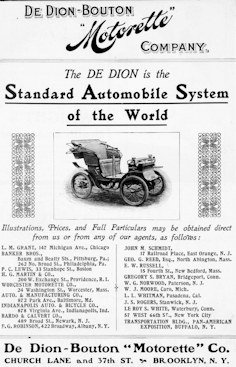De Dion-Bouton Motorette Company

The De Dion-Bouton Motorette Company was a pioneering short-lived US automaker, which rebuilt a Voiturette from De Dion-Bouton under license. Brand name was American De Dion.
History
Already since 1897, efforts were made by the French engine manufacturer and car manufacturer De Dion-Bouton to gain a foothold in the US market. The founders of De Dion-Bouton motorette Company for the construction of single-cylinder engines or possibly Tricycles Both were produced in the US by several companies under license. The first Cadillac had a Leland-Faulconer engine based on De Dion-Bouton patents. Also, for the first models of Pierce and Peerless License versions of the same engine were used.
Although several companies also imported the coveted French De Dion Bouton products to the United States, De Dion-Bouton Motorette Company was the only manufacturer to seek license production from Voiturette Vis-à-Vis. Specifically to set up Fred C. Cocheu, James C. Church, PH Flynn, CJ Field and AA Halsey based company at the intersection 37th Street and Church Lane in Brooklyn (New York). and a capital of US $ 150,000. A sales room was set up at 66th Street West in Manhattan.
American De Dion-Bouton Voiturette Type New York Motorette with 3½ hp from 1900. The design corresponds to the first production model De Dion-Bouton Type D.
Representative of De Dion-Bouton in the United States and thus responsible for the licensing was the lawyer Kenneth A. Skinner, 179 Clarendon Street, Boston (Massachusetts), who also occasionally drove race tricycles. The De Dion-Bouton Motorette Co. had agreed with him on the use of trademark and production rights. As a chief engineer was Viggo V. Torbensen won, who produced the later own automobiles, and a very successful company built for the production of axles for trucks and cars.
First produced was an exact copy of the first in-line De Dion-Bouton Voiturette Type D with tubular steel frame, single-cylinder engine, drawing wedge gearbox and, as the most significant innovations, the in house (developed for their steam cars) De-Dion axle and power transmission by means of cardan shaft. It was a two-seater model Brooklyn motorette and four-seater Vis-à-vis New York motorette 3½ hp or as a two-seater Doctor's Brougham offered with 3½ or 5 hp. As with the original, the prices were also rather high in the license construction; the Runabout Brooklyn Motorette cost from US $ 850. That was US $ 200 more than for the 4½ hp slightly more powerful motorized Oldsmobile Curved Dash were required. Apparently, the company soon ran out of cost and the price was even raised to US $ 1500. That was US $ 300 more than was demanded for the 12 bhp significantly more powerful.


